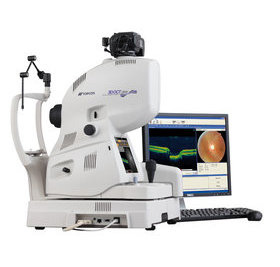Optical Coherence Tomography (OCT)
 Optical Coherence Tomography (OCT) is a non-invasive diagnostic instrument used for imaging the retina. It is the technology for the future because it can enhance patient care. It has the ability to detect problems in the eye prior to any symptoms being present in the patient. With an OCT, doctors are able to see a cross section or 3D image of the retina and detect the early onset of a variety of eye conditions and eye diseases such as macular degeneration, glaucoma and diabetic retinopathy (the top three diseases known to cause blindness).
Optical Coherence Tomography (OCT) is a non-invasive diagnostic instrument used for imaging the retina. It is the technology for the future because it can enhance patient care. It has the ability to detect problems in the eye prior to any symptoms being present in the patient. With an OCT, doctors are able to see a cross section or 3D image of the retina and detect the early onset of a variety of eye conditions and eye diseases such as macular degeneration, glaucoma and diabetic retinopathy (the top three diseases known to cause blindness).
The OCT allows for detection of other diseases such as macular holes, hypertensive retinopathy and even optic nerve damage. Using an OCT allows for early treatment in patients and dramatically improves the success of these treatments, especially in diseases such as wet macular degeneration – where the eye disease progresses rapidly.
The OCT has become the standard of care for the assessment and treatment of most retinal diseases, it is similar to a CT scan which is used to image internal organs inside the body. The OCT uses an array of light to rapidly scan the eye. These scans are interpreted and the OCT then presents an image of the tissue layers within the retina. These layers can be differentiated and their thickness measured. By comparing the thickness of the layers measured by the OCT scan against the normal thickness of healthy retinal layers, eye doctors can determine which retinal disease or eye condition exists in the eye, even before the patient is aware of any problems.
